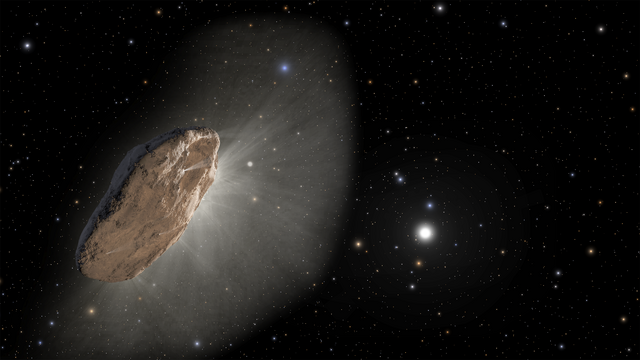
(Photo: Wikimedia Commons/NASA, ESA, Joseph Olmsted (STScI), Frank Summers (STSci))
'Oumuamua is the first object from another star to be confirmed to have visited our solar system. This stony, cigar-shaped, somewhat reddish object that looks like an intergalactic invader has drawn many hypotheses from scientists. There's an ongoing debate whether it's an interstellar object or an alien spaceship.
'Oumuamua Debate: A Work of an Alien Civilization or Interstellar Object?
Avi Loeb, the Head of The Galileo Project and the Director of the Institute for Theory and Computation (ITC), and a Harvard postdoc, Shmuel Bialy, suggested in an equation-heavy piece in The Astrophysical Journal Letters that the most practical explanation for 'Oumuamua's "non-gravitational acceleration" was that it was an artificial object. It could be "a fully operational probe" that had been sent to our solar system to conduct reconnaissance, or it could be the extraterrestrial equivalent of an abandoned automobile, "floating in interstellar space" as "debris."
According to Loeb and Bialy, the second option was more plausible because there would be little chance of us encountering the item if it was just some piece of alien trash floating around the cosmos.
"In contemplating the possibility of an artificial origin, we should keep in mind what Sherlock Holmes said: 'when you have excluded the impossible, whatever remains, however improbable, must be the truth,'" Loeb wrote in a blog post for Scientific American.
The Israeli-American theoretical physicist detailed his reasoning in his book "Extraterrestrial: The First Sign of Intelligent Life Beyond Earth." The idea that 'Oumuamua was driven by solar radiation -- basically, photons bouncing off its surface -- is the only explanation for its peculiar acceleration short of some form of undetectable outgassing. Furthermore, the object would only be able to move in response to solar radiation if it were incredibly thin- no thicker than a millimeter- with a very low density and rather big surface area. Such an apparatus would serve as a sail, but it would be propelled by light instead of wind. Sails are made by people, not by the natural environment.
"'Oumuamua must have been designed, built, and launched by an extraterrestrial intelligence," he added.
Loeb and Bialy's theory received a lot of attention. Many of them disagreed.
"No, 'Oumuamua is not an alien spaceship, and the authors of the paper insult honest scientific inquiry to even suggest it," Paul M. Sutter, an astrophysicist at Ohio State University, wrote.
Benjamin Weiner, an astronomer at the University of Arizona, shared the same opinion. According to him, it was "annoying" that Loeb allegedly promoted speculative theories that 'Oumuamua had alien origins as the rumors forced them to do the scientific work.
What Is 'Oumuamua?
'Oumuamua is extremely extended, reaching up to 400 meters, or a quarter of a mile, and possibly ten times longer than it is wide. This asteroid or comet's aspect ratio is higher than any other seen in our solar system thus far. Its lengthy shape, which sets it apart from objects in our solar system, may provide new insights into the formation of other solar systems.
The International Astronomical Union (IAU), which gives official names to things in the solar system and beyond, formally designated the object 1I/2017 U1. The Pan-STARRS team called it 'Oumuamua (pronounced oh MOO-uh MOO-uh), which is Hawaiian for "a messenger from afar arriving first," in addition to the technical name.
A group of astronomers from the Hawaii Institute for Astronomy, under the direction of Karen Meech, discovered that Oumuamua rotates on its axis every 7.3 hours and that its brightness fluctuates by a factor of 10.
According to Meech, this exceptionally large brightness variation indicates that the item is highly elongated, has an intricate and convoluted shape, and is around ten times longer than wide. Additionally, we discovered that it was reddish in hue, resembling objects in the outer solar system. We verified that it is entirely inert, with not even the tiniest trace of dust surrounding it.
These characteristics imply that 'Oumuamua is dense, made of rock and potentially metals, devoid of ice and water, and that the impacts of cosmic ray radiation over hundreds of millions of years caused its surface to turn red.
RELATED ARTICLE: 'Oumuamua: Scientists Want to Launch A 22 Year Mission For This Extraordinary Object
Check out more news and information on Space in Science Times.














